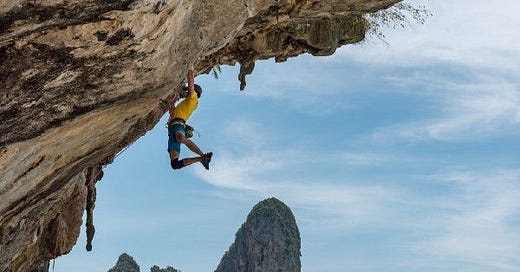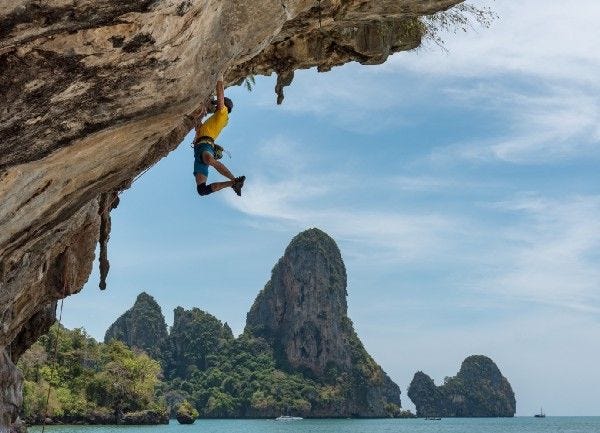Earlier this month I published a post on training for climbing, in which I stated some
excitement about reaching the training age where training is actually useful! The long and the short is that I had to abandon most of the
plans laid out in that post because of some unforeseen work-related circumstances.
Before moving forward though, a word on recovery. In that post I mentioned the idea of recovery economics (like a checkbook) and really
liked the concept. However, I found that the stressors of climbing were too specific.
For example, I still go for walks to clear my head, but
as far as muscle soreness goes, it’s far more helpful after a heavy deadlift day than intense hangboarding. Another example: Massages are
great for everything, but sometimes your fingers just need a break and there isn’t much you can do to rush the process. Most of those recovery
principles dealt with muscular tissue and climbers know that our tendons, specifically in our fingers and forearms, get hammered more than
anything else.
Assessing Training Needs:
I noticed I had gotten myself into a mental rut that I was fortunately able to figure out. I wasn’t sending hard, why? I wasn’t trying hard
(problems). I stepped back and realized that I had yet to see a (in my case) V6 ascent outdoors; but also that the number of V6 problems that
I had actually put in more than 5, or 3, or even 2 sessions on could be counted on one hand.
Queue internet scowering for training maximal strength for climbing. Backing up a moment… You may recall my last post touting significant
progress from doing Anderson style repeaters.
However, I believe that this was working the strength-endurance system. My opposteevidence for this case:
A) the nature of the work:rest ratios,
B) very rapidly accelerating progress, followed soon after by a
D) very rapid rate of detraining (I lost the gains very quickly).
All of that points to a high degreeof training an energy system’s efficiency rather than it’s immediate capacity. In car terms, think fuel economy versus torque. Steve Maisch has an article, On Becoming Self Aware: The R-measure and You, that is helpful here. The process is goes something like this:
Maisch’s simple guideline is that if your R value is less than 55 then you need to train strength / endurance. Conversely, if your R value is
greater than 55 then you should train maximum strength. The value I calculated for myself coincides with my experience at the crag (good stuff!).
How Strong?
Steve’s other compelling article is on fingerboarding for maximal strength.
In that article he lays out a training protocol (see below) as well as a 1 Rep Max type of assessment. Be sure to read the post for details, but
here are my results.
Getting Stronger:
Steve’s prescription is for 10 second reps, so I scaled my failed load (at 13 seconds) to their proportionate value for 10 seconds. For example,
on a middle-two pocket hold I failed at 41 lbs. added, so: (10 / 13) * 41 = ~32 lbs.
Going off Maisch’s prescribed workout, and some other periodizatoin information I’ve gathered, here’s what the next few weeks will look like for me:
Weekly routine: 2 strength sessions, 1 endurance session (see upcoming post on energy systems)
Cragging: Trad counts as that weeks endurance session, bouldering counts as a strength session
Strength Training (if at home): Follow Maisch’s hangboard routine
Strength Training (if at gym): Focus on 5 move maxes, with ~5 minute rest between attempts, ~5 attempts per sequence. Stop before 90 minutes.
Endurance (anywhere): Either 10 min walk / run or boulder for V-Points @ 10 minute block, rest 10 minutes, repeat 2x
Healing:
As part of all the reading, planning, and assessing I’ve been doing during this rest week. I’ve also been reading up on trigger point therapy,
acupressure, self massages, and yoga for hip and shoulder mobility.
All of those links are excellent resources and could easily be packed into a 10 minute cooldown after any workout. There are also two major types
of elbow tendinitis. Eric Horst has a free article on golfer’s elbow
and treatment thereof.
However, I actually suffer from the opposite motion, “tennis elbow.” I suspect this is because I fancy spanking and compressing big, fat, powerful splopers — thereby forcefully turning my hand inward, not outward. The remedy is similar, but rotating the hand exercises (in link above) the other direction (thumb-down to thumb-up rather than thumb-out to thumb-up).
Resting:
10/4/16 Update : Like many training articles I forgot to include this, but I had been thinking about it. The gist so far is that I want my R value to become
more balanced and I’d prefer that come from improving maximal strength rather than decreasing strength endurance. It’s easy to think you’ll go all Rocky Balboa, but it’s actually important to do less. When training at high intensities you need more recovery time, not just between sets, but between workouts. You also need to be fully recovered to be getting the most out of those workouts as well. The short version is looking like this for me:
Given Weekend Climbing Following Training Week:
1 Trad Day / Weekend
1 strength / hang session before trad day, another 3 days after
2 Trad Days / Weekend
Avoid, save for a aerobic training phase
1 Boulder Day / Weekend
2 rest days, strength day, rest day, aerobic day, rest day
2 Boulder Days / Weekend
Make the 2nd day a volume day, rest 2 days, strength day, rest 2 days
Support my work by visiting my affiliate sponsors!




